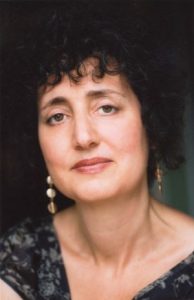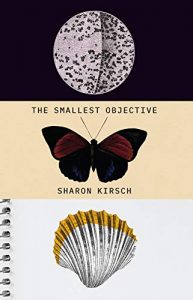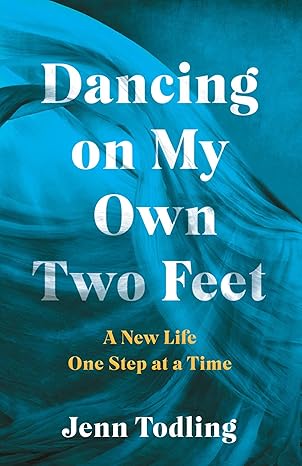Excerpt of THE SMALLEST OBJECTIVE
The subject of memory is foremost in The Smallest Objective, a memoir of loss and retrieval set during the years when the author’s mother is afflicted with dementia. For World Alzheimer’s Month—September—Sharon Kirsch offers this abridged excerpt from her memoir. In the section below, the author becomes mesmerized by her aunt’s wedding—a subject that remained taboo during her mother’s more lucid years. Here memory loss confers permission for the author to imagine the formerly unspeakable fate of her mother’s sister.
Excerpt from The Smallest Objective by Sharon Kirsch (New Star Books, 2020)
More than any other sequence in the movie Carol and Marvin’s Wedding, I watch time a nd again the beginning — the December morning when the grass is still green and without snow cover, and my mother’s sister descends the steps of 4885 Queen Mary Road with her best friend and her parents at her side. Two children are standing by, one in a red hat, as my grandfather ushers the women into a chauffeur-driven chrome and black sedan. The day seems neither bright nor dark and is dry yet windy. Carol holds her short veil tight as she prepares for her last ride under her father’s name.
nd again the beginning — the December morning when the grass is still green and without snow cover, and my mother’s sister descends the steps of 4885 Queen Mary Road with her best friend and her parents at her side. Two children are standing by, one in a red hat, as my grandfather ushers the women into a chauffeur-driven chrome and black sedan. The day seems neither bright nor dark and is dry yet windy. Carol holds her short veil tight as she prepares for her last ride under her father’s name.
As the film progresses, there’s no moment when the groom lifts the veil and the bride’s face is revealed. Carol and Marvin’s Wedding favours the before and after, the unidentified cameraman excluded from the inner sanctuary of the synagogue. And peculiar to this film is the extent of black. The men, naturally, wear black tuxes, but the women too have opted for black — close-fitting, knee-length black dresses with black pillbox hats, a few hats with fine netting that extends over the eyes. At the wedding reception, the younger women drink pale pink cocktails.
As the double doors open and Carol and Marvin make their way through the dense crowd, she’s radiant, he more reticent. Sixteen years her senior and an established businessman, he looks at times as though he’s being sidelined at his own wedding. A lithe young man in dark glasses plays exuberantly at a small keyboard. The camera pans to the high table, where my father, red-faced, is cramming something elongated into his mouth. Beside him, his wife, my mother, is resplendent in gold lamé. As Carol and Marvin prepare to kiss, my grandfather fumbles for a cigarette, lighting up as the kiss is consummated. The only food that merits a close-up is the wedding cake. It exhibits no plastic bride and groom for storage in a dresser drawer. Instead, the apex of the cake is a bent bough of pale pink roses that will shed their petals but have been spared their thorns.
Carol’s never seen throwing her bouquet. In the last glimpse of the newlyweds, both are unsmiling. Solemn. The movie ends abruptly, with a momentary lapse into darkness and then the recovery of light, the final image an unknown thumbprint on a section of blank film.
Less than five years after the filming of Carol and Marvin’s union, the female lead, my mother’s only sibling, has been withdrawn.
***
My mother, before she lost her memory, assumed I had no recall of her sister. “This is where my sister collapsed before she miscarried,” she’d say to me, her only child, as we drove past the prim turf of the Westmount Lawn Bowling Club on the approach to Greene Avenue, or “My sister was a rebel. She never let our parents boss her around.” Always in these statements my mother referred to Carol as “my sister” or “my late sister,” never as “your aunt.”
That I was four and a half at the time of my aunt Carol’s death, an age when children are known readily to form lasting memories, had bypassed my mother. Even children approaching two are now believed to retain memories extending as far back as six months. As toddlers or older infants, we allegedly create and retrieve memories that later become lost to us. As adults, we typically are able to recall a first memory from no earlier than the age of three and a half, when our sentences rarely exceed several words and our interrogations are characterized by “Why?” and “What?”
Had I been a few years older at the time of Carol’s death, her tragedy might have troubled me longer and more overtly. Instead, for almost fifty years, until my mother was nearing the end of her own life, I gave little thought to my aunt and how her death had reformulated my young mother’s future. At the very mention of my aunt’s name I fell silent or directed the conversation elsewhere, to a present Carol wasn’t privileged to share.
***
By the time I finally began to wonder about my aunt Carol, I was travelling to Montreal every few weeks to remind my own mother that she had a daughter. It had been eighteen months since I’d confined my mother to assisted living, and I no longer had her house to preoccupy me, nor did I have the advantage of companionship. The friends who’d helped with the dismantling of my mother’s house had returned to their respective homes, as had my husband. My mother herself had become my pursuit, my composure undermined as I observed she was speaking less and sleeping more. Annie, the night-sitter, gave me detailed accounts from notes she scribbled by flashlight. “Oh yes, she gets up in the night. She thinks it’s mealtime. I give her a snack, but fast. She has no patience.”
My mother’s declining awareness brought a single advantage for me. It had become easier to investigate Carol, a subject now removed from my mother’s remembrance of her distant past. While still in possession of my mother’s house, I’d recovered a confusion of loose photos of Carol — from my grandparents’ leatherette suitcase or my mother’s stash kept in a padded silk glovebox the colour of offal. Yet in my mother’s apartment sat various family albums, along with several unexplored boxes of memorabilia I’d transferred from the family home. All of these, I ventured, might afford a more coherent narrative of Carol’s too-short life.
—
Find out more about Sharon on her website https://sharonkirsch.com/
Media Contact: Janis Kirshner, jkirshner@sympatico.ca
THE SMALLEST OBJECTIVE
 From the author of What Species of Creatures, Sharon Kirsch, comes The Smallest Objective, an intricate and melancholy personal memoir about a daughter’s last days with her mother, the hidden recesses of family history, and the treasures that the past can bring in the face of a difficult present.
From the author of What Species of Creatures, Sharon Kirsch, comes The Smallest Objective, an intricate and melancholy personal memoir about a daughter’s last days with her mother, the hidden recesses of family history, and the treasures that the past can bring in the face of a difficult present.
Having moved her elderly mother into a care home, the author of The Smallest Objective must now empty the family home of half a century, discovering as she does so a series of small objects that unlock her family’s past: a lantern slide, a faded recipe book, a postcard from Mexico, a nugget of fool’s gold.
With the object of staving off grief while attending to her mother’s final days, Sharon embarks on a quest to retrieve the origin and circumstances surrounding each of these articles. Along the way, she uncovers the stories of several early- to mid-century Montreal Jewish personalities — a Runyonesque hustler, a Lithuanian botanist, and a self-made young woman — as well as the extent to which they were punctured and shaped by the muffled anti-Semitism of the time.
The Smallest Objective examines the minutiae of lives lived, our concern for senior members of our family, the time we need to sift, take stock, and filter out the important things, and the consolation offered by staying close to loved ones even when we can’t reach them.
Get the book HERE
Category: On Writing




























